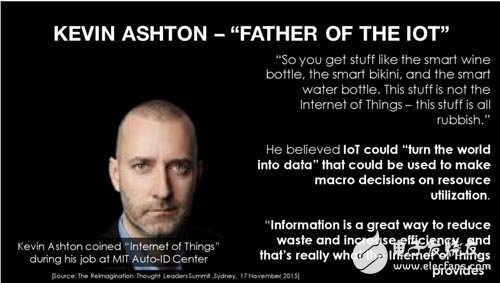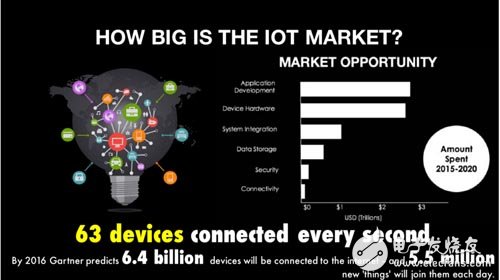The 46-year-old "Technology Control" Kevin Eich, who was born in the United Kingdom and now lives in the United States, first proposed the concept of The Internet of Things in 1999. Subsequently, in 2005, the International Telecommunication Union (ITU) held the World Summit on the Information Society in Tunisia to formally define the concept of the Internet of Things.
His latest speech is as follows: The Internet of Things is a physical-based Internet. Its emergence is inseparable from the rapid development of wireless communications, smart mobile devices, big data, processors, sensors and other fields in the past decade. Among them, the development of sensors. Including physical sensors based on the principles of optics, pressure, electromagnetic fields, etc., based on chemical reaction sensors, integration, sensitivity and cost are getting better and better.
In terms of network architecture, wireless network forms based on protocols such as Bluetooth, Wi-Fi, and LTE are becoming more and more mature, and wireless base station signals gradually cover most urban areas. In addition, the division of labor between human and computer is becoming more and more clear, enabling relatively sensitive digital network input, processing, execution and feedback mechanisms.


Market size of the Internet of Things
Xively analysis of the Internet of Things PaaS platform shows that by 2020, there will be 40-80 billion devices connected to the Internet of Things, of which government equipment will account for at least 7.7 billion, with a total value of about 2.1 billion US dollars. The estimated return on investment is 4.7 billion US dollars. There will be 10 IoT devices. According to Gartner's market research report, the number of devices connected to the Internet of Things per second will reach 63 units per day, which is 5.5 million units per day. It is expected that the Internet of Things market will reach the scale of 100 billion in 2015-2020.

On the enterprise side, IoT equipment is expected to reach 11.2 billion units by 2020, valued at US$3 billion, and is expected to generate US$7.6 billion. This will create revenue projects for 30% of companies, 29% will adopt new work and decision-making methods, 23% will change existing business models, 17% will be able to use IoT technology to reduce costs, 16% will borrow This opportunity will enter new fields and new markets, 13% will invest more funds in technology, 9% will still retain the inherent business model, 8% will face more entrepreneurs to join the industry competition, 7% will strengthen Partnership with competitors.
In addition, according to PwC data, 35% of manufacturing industries have adopted intelligent sensors, 10% are expected to be installed within 1 year, and 8% are expected to be installed within 3 years. BI Intelligence believes that the energy industry, including oil, natural gas, coal mines, etc., will have 5.4 million IoT devices involved in exploration and mining within five years. In terms of transportation, it is estimated that there will be 220 million IoT vehicles by 2020. In terms of insurance, SMA Research said that 74% of insurance company executives intend to introduce IoT technology.

On the defense front, Frost & Sullivan reported that $8.1 billion will be spent on drones in 2020, with an estimated 126,000 military robots. In terms of smart homes, Navigate Research believes that there will be 1.1 billion smart home products in 2022. In agriculture, there are an estimated 75 million IoT devices in 2020, with a compound annual growth rate of 20% per month. In the food service industry, BI expects to have 75 million IoT devices in 2020, with a compound annual growth rate of 20% per month.
In the infrastructure sector, the IoT system is expected to grow at a compound annual growth rate of 30%. The scale will increase from US$36 billion in 2014 to US$133 billion in 2019, generating US$421 billion. In 2020, 1 billion intelligent communication base stations will be built. In the retail industry, the United States is expected to increase revenue by 44.4 billion US dollars. In the medical industry, Hospitality Technology research shows that 31% of hospitals in 2015 have adopted a new generation of door locks, 33% have control systems, 16% have connected TVs, and 15% have completely used new technology.
In terms of logistics, Amazon's Kiva has begun to emerge. In the health sector, 646 million devices are expected to be used to focus on health in 2020. In terms of banks, more than 3 million ATMs around the world are gradually equipped with real-time streaming information display capabilities. In terms of smart buildings, Daintree Networks said that 43% of US construction managers believe that the Internet of Things will affect the way buildings are built in the next two or three years.
we are the best supplier in China to offer the networking tools including sort of insertion tools, impact and punch down tool (Ericsson punch down tool, Siemens punch down tool, Corning punch down tool and so on), crimping tool(RJ45 crimping tools, coaxial cable crimping tool, picabond ratchet crimper), cable stripper and cutter, Cable Tester and connector removal tool, and so on.
In short, we offer the networking tools for cutting and stripping coaxial cable, twist cable, and optical fiber. And professional compression crimping tool for different connectors, insertion tools for different modules .To save cost for customers, we have desired some tools with multi-function. So you can keep one tool instead of several different types. Meanwhile, for some coaxial cable crimping tool you can change the head to fit the cable specification yourself. It will make you lose weight on tool set but to finish your work perfectly.

Insertion Tool, Punch Tool, Cat 5 Cable Tester, Crimping Pliers, Cable Crimping Tool
NINGBO YULIANG TELECOM MUNICATIONS EQUIPMENT CO.,LTD. , https://www.yltelecom.com
